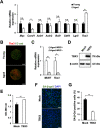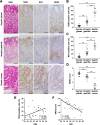Suppressed Cellular Senescence Mediated by T-box3 in Aged Gastric Epithelial Cells may Contribute to Aging-related Carcinogenesis
- PMID: 36923312
- PMCID: PMC10010334
- DOI: 10.1158/2767-9764.CRC-22-0084
Suppressed Cellular Senescence Mediated by T-box3 in Aged Gastric Epithelial Cells may Contribute to Aging-related Carcinogenesis
Abstract
Aging is a risk factor for cancers in various organs. Recent advances in the organoid culturing system have made it viable to investigate the influence of aging utilizing these mini organs. In this study, we aimed to examine the implications of aging for gastric carcinogenesis. Gastric organoids established from aged mice grew larger, proliferated vigorously, and survived longer than that from young mice. Because Wnt/β-catenin signaling was intensified in the aged organoids and because removal of Wnt-related factors diminished their proliferation, we investigated for Wnt target gene that contributed to enhanced proliferation and discovered that the aged organoids expressed the transcription factor T-box3 (Tbx3), which has been reported to suppress cellular senescence. Indeed, cellular senescence was suppressed in the aged organoids, and this resulted from enhanced G2-M transition. As for the mechanism involved in the intensified Wnt/β-catenin signaling, we identified that Dickkopf3 (Dkk3) expression was reduced in the aged organoids due to methylation of the Dkk3 gene. Finally, the expression of TBX3 was enhanced in human atrophic gastritis and even more enhanced in human gastric cancers. In addition, its expression correlated positively with patients' age. These results indicated that the emergence of antisenescent property in aged gastric organoids due to enhanced Tbx3 expression led to accelerated cellular proliferation and organoid formation. Because the enhanced Tbx3 expression seen in aged gastric organoids was also observed in human gastric cancer tissues, this Dkk3-Wnt-Tbx3 pathway may be involved in aging-related gastric carcinogenesis.
Significance: This work provides an insight into the mechanism involved in aging-related gastric carcinogenesis through studies utilizing organoids established from young and aged murine stomachs.
© 2022 The Authors; Published by the American Association for Cancer Research.
Conflict of interest statement
N. Asano reports grants from Japanese Society for the Promotion of Science during the conduct of the study. A. Imatani reports grants from Japan Society for the Promotion of Science during the conduct of the study. No disclosures were reported by the other authors.
Figures





References
Publication types
MeSH terms
Substances
LinkOut - more resources
Full Text Sources
Medical
Molecular Biology Databases
Research Materials

